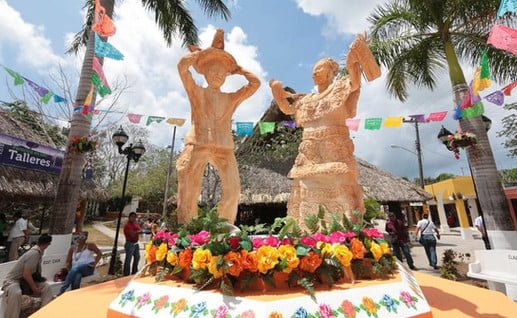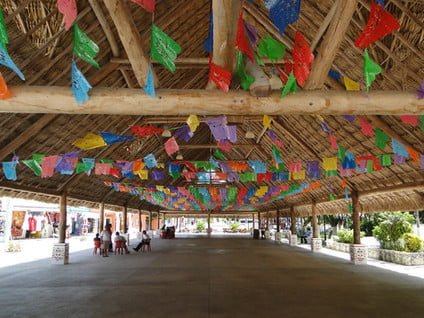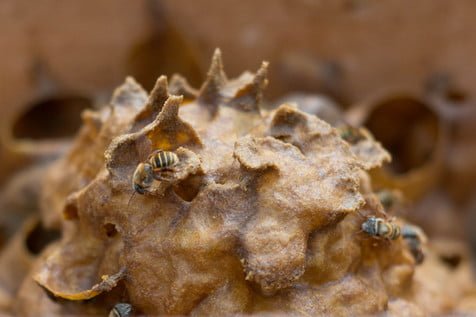Culture & History
Cozumel can mesmerize you with its turquoise waters and sandy beaches.
Soon you realize you are standing on sacred land, full of history, legends and traditions that go beyond its breath taking sunrises and sunsets. There is a reason why Cozumel was such an important place to the Mayan civilization and to began to understand this you cannot miss the museum, archeological ruins and all of the important sites that make the island such an incredible experience. Here is our list to get you started!
1. San Gervasio




San Gervasio is a unique archaeological site of the pre-Columbian Maya civilization, located in the northern third of Cozumel. Its history, nature and strong energy will grab your attention once you take a step on this sacred land. We highly recommend you hire a guide, even if you usually don’t consider this option in any other occasion. This is a good time to make an exception.
Put on some comfortable shoes and be ready for an amazing 1.5-2 hours journey that will take you to the roots of Mayan civilization.
The ruins were once a hub of worship of the goddess Ixchel, a deity of childbirth, fertility, medicine, and weaving. Pre-Columbian Maya women would try to travel to San Gervasio and make offerings at least once in their lives. This tradition is still alive and supported by not only locals but also foreigners, coming to goddess Ixchel asking for help. Some of the stories that we’ve heard are pretty incredible.
The site is made up of various architectural ensembles linked by a network of white paths. Its main groups are called Manitas, Chichán Nah (“Small House”), El Álamo, Nohoch Nah (“Great House”), Murciélagos, Ka’na Nah (“High House”) and El Ramonal.
Archaeological works show that the pre-Hispanic settlement was founded around 300 AD, when it was a small settlement, although it was already the largest on the island.
From the year 1000, with the emergence of Chichén Itzá as the great political and economic center of the peninsula, the site was integrated into an increasingly intense economic network, which was to lead it to become the great city that was from 1200 AD During the late Postclassic (1200 – 1450 AD), most of the buildings that can be seen today were built, establishing a network of minor communities, dependent on San Gervasio and located throughout the island.
Make sure to schedule your visit for early morning to enjoy your experience the most. No reservation needed.
2. El Cedral: Annual fair and the oldest Mayan ruins on the island






El Cedral is a small beautiful village that was built in the year 800 after Christ located to the south of the island. It was once the largest community and the capital of Cozumel and makes up the set of 36 cities built by the Mayans in this region.
The history of Cozumel cannot be conceived without the celebration of the El Cedral fair, a festival of purely religious origin that has evolved over time.
Casimiro Cárdenas was the initiator of the tradition that has began between according to historical research in 1848 and 1849.
It was originally a celebration of the Day of the Holy Cross on May 3 as a promise by Cárdenas after surviving a massacre perpetrated by Mayan rebels during the Caste War in the town of Sabán in 1847.
If you are visiting Cozumel and the Riviera Maya, a very good option is to travel when the “El Cedral Fair” takes place, between the end of April and the beginning of May, since it is its most important festivity. During these days you will enjoy tastings of typical food and drinks, folkloric dances of the region, horseback riding and much more.
Oldest Mayan ruins in Cozumel are also located in El Cedral, next to a Catholic church in the heart of the town (behind the main square). To read more about this archaeological site and see a picture of ruins, taken by the man who once owned Chichen Itza – click the link.
(say something about nature, calming energy, nice cozy houses and even cenote, nearest beaches to go after, souvenir stores on the main square)
3. Museo de la Isla de Cozumel

Learn about local history, geography and ecosystems visiting our freshly renovated museum of the island, located on the main street right in front of the sea. The museum dates back to 30s and was originally one of the first hotels on the island.
4. Take a Walk Downtown







There is nothing more simple and beautiful than taking a walk downtown during a sunset. It gets nice and cool, you can enjoy the views and take some wonderful pictures. Starting from the park Benito Juarez, make a right to Melgar and go all the way down to the airport blvd. Great way to enjoy the sea views, and the local people of the island. Learn about the history of the clock tower , stop by Museo de la isla de Cozumel and do not forget to visit Ixchel – the goddess of abundance and fertility. On the way back you may want to check out our list of the best dining spots in Cozumel, such as El Palomar or Guidos located just a couple of blocks away from the museum of the island.
5. KAOKAO Cacao Factory

According to Mayan beliefs, cacao was founded by their gods. That’s why cacao is termed “food of the gods.” Discover the Bean to Bar Chocolate Making process inside this chocolate factory, learn about the tools and ingredients used by Mayans to make the sacred beverage: “chocolhaa” (hot cocoa). Craft your own chocolate and taste samples during the process starting from roasted cacao beans to the actual products you can purchase at a local store and take back home.
6. The Mayan Cacao Company




The Mayan Cacao Company is another great place to discover the origins of chocolate on the land of their creators. It is an interactive place, where you explore the history of this popular product. It is located only 15 minutes away from downtown, good option if you are planning a trip to one of the beaches on the South side of the island. Check out our list of the best beaches!
7. Carnaval

Due to its age and magnitude, it is one of the most important carnivals in Mexico. This spectacular event has almost 150 years of history on the island, and is held around February every year. The first Carnival that took place in Cozumel was in 1874, and it has been kept alive without interruption throughout the years.
This important festivity includes the coronation of carnival kings and queens, parades of allegorical cars, dance troupes dressed in costumes of lights, costumes and original masks; concerts and the traditional “Quema de Juan Carnaval” to end the celebration.
Visit Cozumel during one of its famous festivities and get to know its Caribbean vibe and festive atmosphere, it will certainly be an experience you will never forget!
8. Temazcal




Temazcal is a low heat mayan steam lodge , which has been in the area since pre-Hispanic times. Besides promoting physical well-being and healing, temazcal is first of all a spiritual practice, ritual that cleans us on physical and energetic levels. Temazcal represents a womb of our Mother Earth and people coming out of the bath are, in a symbolic sense, re-born.
Enjoy Temazcal experience at Chancanaab.
9. Mayan Bee Sanctuary








The Mayan Bee Sanctuary is a wonderful place where you can discover the stingless bees and traditions of Mexico. It’s an interactive space located in the middle of jungle, in which they have beautiful cenote, a large store with honey-based products you can only imagine. Located close to San Gervasio and should definetely become a part of your journey to the Eastern side of the island.
